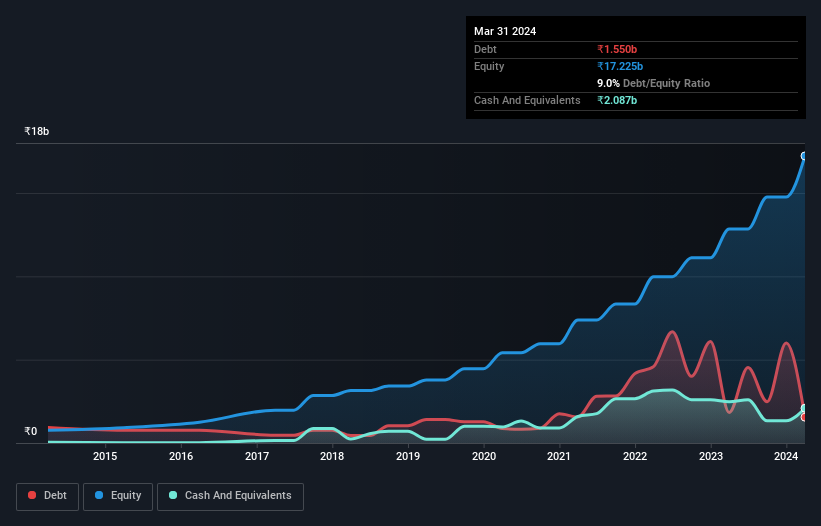- India
- /
- Consumer Durables
- /
- NSEI:DIXON
Dixon Technologies (India) (NSE:DIXON) Seems To Use Debt Quite Sensibly
Legendary fund manager Li Lu (who Charlie Munger backed) once said, 'The biggest investment risk is not the volatility of prices, but whether you will suffer a permanent loss of capital.' So it seems the smart money knows that debt - which is usually involved in bankruptcies - is a very important factor, when you assess how risky a company is. As with many other companies Dixon Technologies (India) Limited (NSE:DIXON) makes use of debt. But should shareholders be worried about its use of debt?
When Is Debt Dangerous?
Debt and other liabilities become risky for a business when it cannot easily fulfill those obligations, either with free cash flow or by raising capital at an attractive price. Part and parcel of capitalism is the process of 'creative destruction' where failed businesses are mercilessly liquidated by their bankers. However, a more frequent (but still costly) occurrence is where a company must issue shares at bargain-basement prices, permanently diluting shareholders, just to shore up its balance sheet. By replacing dilution, though, debt can be an extremely good tool for businesses that need capital to invest in growth at high rates of return. When we think about a company's use of debt, we first look at cash and debt together.
Check out our latest analysis for Dixon Technologies (India)
How Much Debt Does Dixon Technologies (India) Carry?
You can click the graphic below for the historical numbers, but it shows that Dixon Technologies (India) had ₹1.55b of debt in March 2024, down from ₹1.83b, one year before. But it also has ₹2.09b in cash to offset that, meaning it has ₹536.2m net cash.

How Healthy Is Dixon Technologies (India)'s Balance Sheet?
We can see from the most recent balance sheet that Dixon Technologies (India) had liabilities of ₹47.3b falling due within a year, and liabilities of ₹5.37b due beyond that. On the other hand, it had cash of ₹2.09b and ₹23.2b worth of receivables due within a year. So its liabilities total ₹27.4b more than the combination of its cash and short-term receivables.
Of course, Dixon Technologies (India) has a market capitalization of ₹545.8b, so these liabilities are probably manageable. Having said that, it's clear that we should continue to monitor its balance sheet, lest it change for the worse. Despite its noteworthy liabilities, Dixon Technologies (India) boasts net cash, so it's fair to say it does not have a heavy debt load!
In addition to that, we're happy to report that Dixon Technologies (India) has boosted its EBIT by 33%, thus reducing the spectre of future debt repayments. The balance sheet is clearly the area to focus on when you are analysing debt. But ultimately the future profitability of the business will decide if Dixon Technologies (India) can strengthen its balance sheet over time. So if you want to see what the professionals think, you might find this free report on analyst profit forecasts to be interesting.
Finally, a company can only pay off debt with cold hard cash, not accounting profits. Dixon Technologies (India) may have net cash on the balance sheet, but it is still interesting to look at how well the business converts its earnings before interest and tax (EBIT) to free cash flow, because that will influence both its need for, and its capacity to manage debt. Over the last three years, Dixon Technologies (India) reported free cash flow worth 9.4% of its EBIT, which is really quite low. For us, cash conversion that low sparks a little paranoia about is ability to extinguish debt.
Summing Up
While it is always sensible to look at a company's total liabilities, it is very reassuring that Dixon Technologies (India) has ₹536.2m in net cash. And we liked the look of last year's 33% year-on-year EBIT growth. So we are not troubled with Dixon Technologies (India)'s debt use. When analysing debt levels, the balance sheet is the obvious place to start. But ultimately, every company can contain risks that exist outside of the balance sheet. To that end, you should be aware of the 1 warning sign we've spotted with Dixon Technologies (India) .
At the end of the day, it's often better to focus on companies that are free from net debt. You can access our special list of such companies (all with a track record of profit growth). It's free.
New: Manage All Your Stock Portfolios in One Place
We've created the ultimate portfolio companion for stock investors, and it's free.
• Connect an unlimited number of Portfolios and see your total in one currency
• Be alerted to new Warning Signs or Risks via email or mobile
• Track the Fair Value of your stocks
Have feedback on this article? Concerned about the content? Get in touch with us directly. Alternatively, email editorial-team (at) simplywallst.com.
This article by Simply Wall St is general in nature. We provide commentary based on historical data and analyst forecasts only using an unbiased methodology and our articles are not intended to be financial advice. It does not constitute a recommendation to buy or sell any stock, and does not take account of your objectives, or your financial situation. We aim to bring you long-term focused analysis driven by fundamental data. Note that our analysis may not factor in the latest price-sensitive company announcements or qualitative material. Simply Wall St has no position in any stocks mentioned.
About NSEI:DIXON
Dixon Technologies (India)
Manufactures and sells electronic goods in India and internationally.
Solid track record with excellent balance sheet.
Similar Companies
Market Insights
Community Narratives



